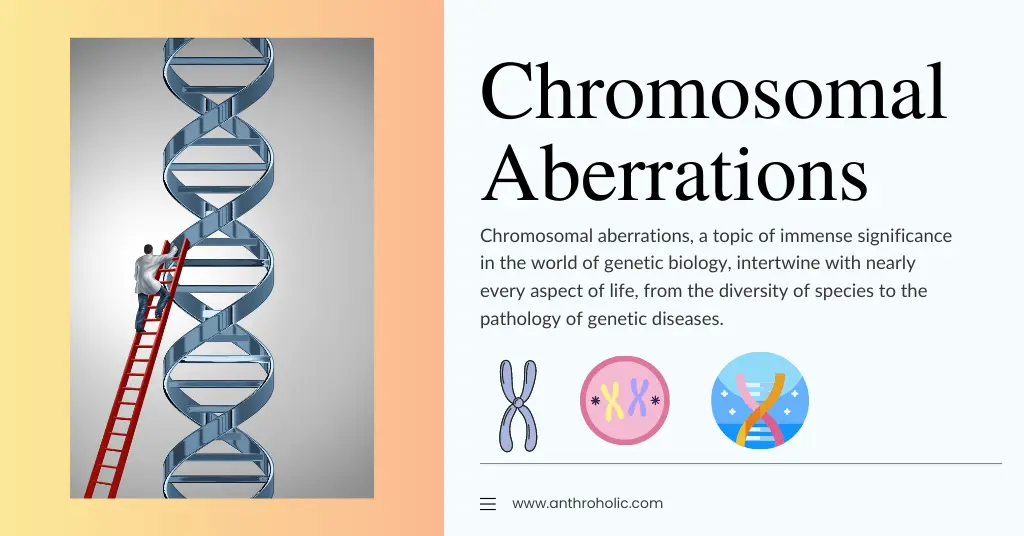AI Answer Evaluation Platform Live Now. Try Free Answer Evaluation Now
Chromosomal Aberrations
Chromosomal aberrations, a topic of immense significance in the world of genetic biology, intertwine with nearly every aspect of life, from the diversity of species to the pathology of genetic diseases. They are deviations from the standard genetic blueprint – the shifts and shuffles in our DNA that can create vast biological variations or insidious medical conditions. The investigation of chromosomal aberrations necessitates an understanding of chromosomes, their structure, and the ways they may deviate from the norm.

Chromosomes, which exist in every cell of the body, house genes – the basic units of heredity. Humans typically have 46 chromosomes, 23 from each parent, neatly packaged into the cell nucleus. However, when discrepancies occur in this tidy arrangement, we enter the realm of chromosomal aberrations. These anomalies can result in a myriad of conditions, such as Down Syndrome, Klinefelter Syndrome, and Turner Syndrome, or they may lead to spontaneous miscarriages.
Structural Aberrations and Numerical Aberrations
Chromosomal aberrations can be broadly categorized into structural aberrations and numerical aberrations.
Structural Aberrations
Structural aberrations involve changes to the physical structure of the chromosomes. They generally arise due to breakages and faulty repairs in the DNA sequence, leading to deletions, duplications, inversions, or translocations.
- Deletions: A section of the chromosome is lost or deleted. This can result in a partial or complete absence of essential genes.
- Duplications: Here, a portion of the chromosome is duplicated, leading to an excess of certain genes.
- Inversions: A segment of the chromosome is reversed end to end.
- Translocations: Parts of one chromosome are transferred to another chromosome.
Numerical Aberrations
Numerical aberrations are errors in cell division resulting in cells with extra or missing chromosomes. Two main types are monosomy and trisomy.
- Monosomy: When a single chromosome is missing from the normal complement. Turner syndrome, resulting from a missing X chromosome, is a notable example.
- Trisomy: When there is an extra chromosome in addition to the normal complement. Down syndrome, caused by an extra chromosome 21, is a well-known instance.
The Mechanism of Chromosomal Aberrations
It is important to delve into how these chromosomal aberrations arise. Most chromosomal aberrations occur during meiosis, the cell division process that creates gametes – eggs in females and sperm in males. Problems can occur during the pairing and separation of chromosomes, leading to gametes with too many or too few chromosomes.
A leading cause of chromosomal aberrations is nondisjunction, a failure of chromosomes to separate properly during meiosis. This results in one cell receiving an extra chromosome and another receiving one less.
| Types of Aberration | Mechanism | Examples |
|---|---|---|
| Deletion | Loss of chromosome segment | Cri-du-chat syndrome |
| Duplication | Repeated chromosome segment | Charcot-Marie-Tooth disease type 1A |
| Inversion | Reversal of chromosome segment | Infertility |
| Translocation | Exchange of segments between nonhomologous chromosomes | Chronic Myeloid Leukemia |
| Monosomy | Loss of one chromosome from a pair | Turner syndrome |
| Trisomy | Addition of an extra chromosome | Down syndrome |
Effects of Chromosomal Aberrations
Chromosomal aberrations can have far-reaching consequences on an organism’s phenotype. They can lead to various disorders, physical abnormalities, and even increase susceptibility to certain diseases. Chromosomal aberrations play a critical role in cancer development. For example, the Philadelphia chromosome, a translocation between chromosomes 9 and 22, is found in most cases of chronic myeloid leukemia.
Conversely, chromosomal aberrations can contribute to genetic diversity, leading to evolutionary advancement. For example, some structural aberrations may create new combinations of genes, leading to advantageous traits.
Conclusion
While they can lead to a spectrum of health conditions, chromosomal aberrations also contribute to the genetic diversity that propels evolution. They epitomize the delicate balance of life: a small genetic shift can either be a boon or a curse. Understanding chromosomal aberrations is pivotal to advances in genetic therapies, disease prevention, and appreciation of our genetic heritage.
References
- Alberts, B., Johnson, A., Lewis, J., Raff, M., Roberts, K., & Walter, P. (2002). Molecular Biology of the Cell. 4th edition. New York: Garland Science. Retrieved from https://www.ncbi.nlm.nih.gov/books/NBK26840/
- Gardner, R. J. M., & Sutherland, G. R. (2004). Chromosome abnormalities and genetic counseling. Oxford University Press.
- Nussbaum, R. L., McInnes, R. R., & Willard, H. F. (2007). Thompson & Thompson genetics in medicine. Philadelphia: Saunders/Elsevier.



